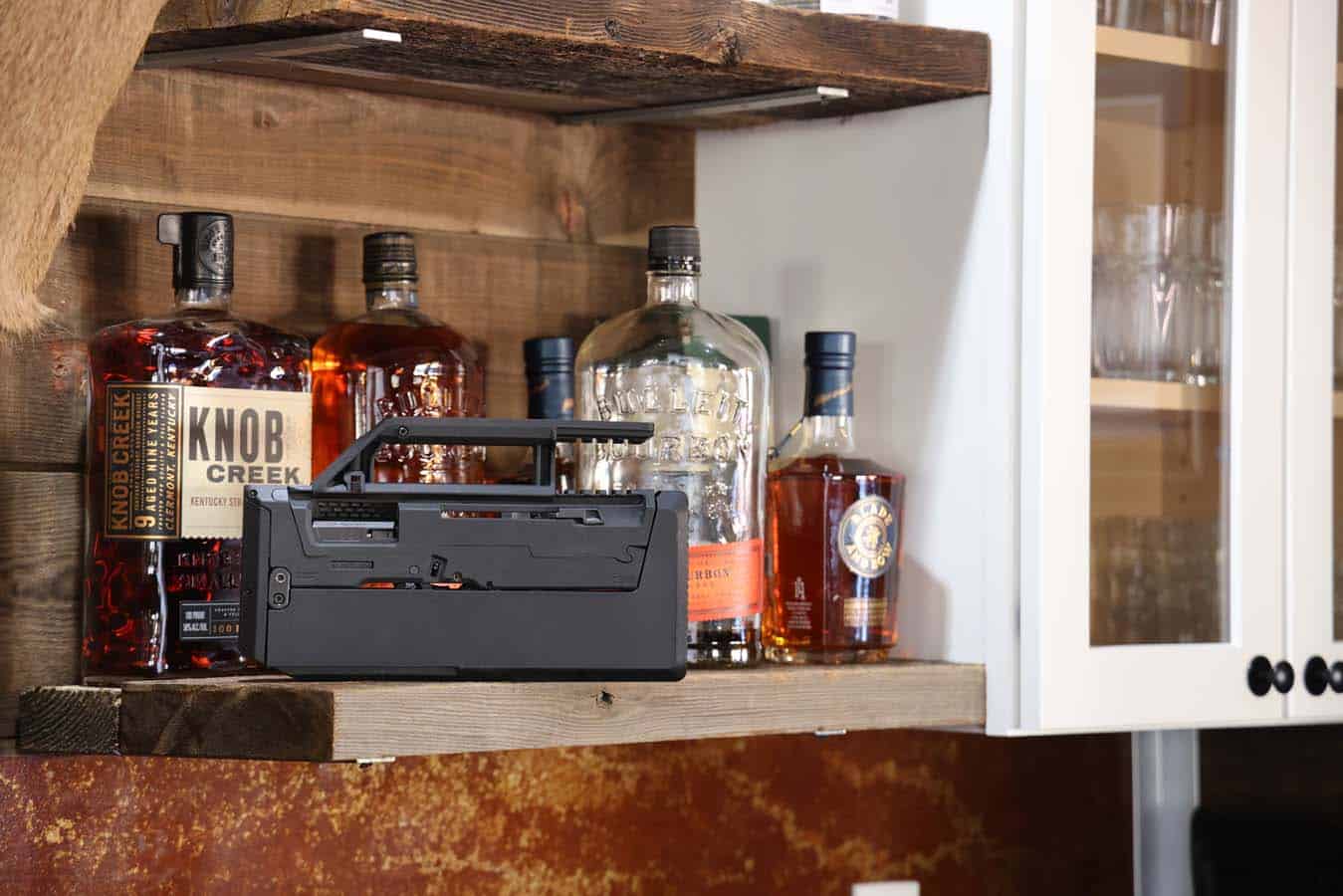Magpul Industries Corporation is now synonymous with their ubiquitous polymer magazines. But that’s not how they got their start back in 1999.
Back in the day, when founder Richard Fitzpatrick served in the Marines, operators would attach loops of paracord or duct tape to their magazines to make it easier to grab them and yank them out of mag pouches.
Magpul’s initial innovation was the original “Magpul” magazine accessory, a synthetic rubber loop that you attached to the bottom of your magazines, which worked way better than paracord and tape. Today, Magpul’s an anchor in the gun industry, with a wide range of firearms accessories and a hard-earned expertise with polymer and composite materials.
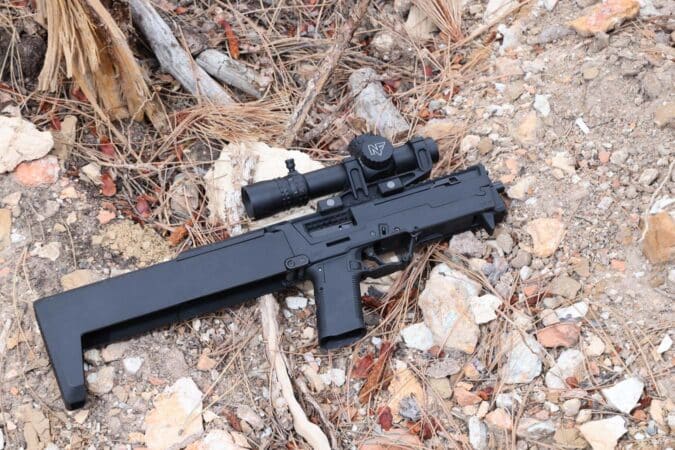
If you’re new to firearms, you might not realize that between then and now, back in the late 2000s, Magpul also developed a number of interesting firearms designs, though they never moved into manufacturing guns themselves.
Their Magpul Masada rifle concept, for example, was licensed to Bushmaster and eventually brought to market as the Bushmaster ACR.
Another interesting concept that Magpul developed was the FMG-9, for Folding Machine Gun. With the guts of a Glock 17 and feeding from Glock magazines, it was designed to be an extremely concealable, rapidly deployable, folding personal defense weapon.
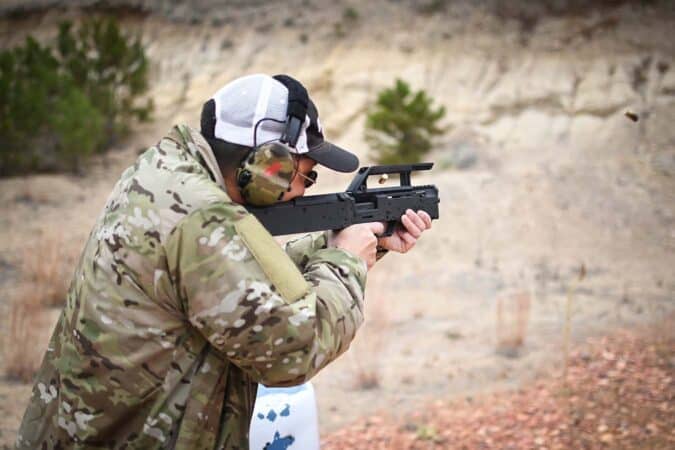
When folded, it looked like a small plastic case with a carrying handle. At the touch of a button, it flipped open to become a small pistol-gripped PDW with a short stock. It was originally designed by Magpul cofounder Mike Mayberry, inspired by folding guns from the 1970s and ’80s such as the UC-9, M-21, and ARES FMG. Only one prototype of the FMG-9 was made, and after being shown at the 2008 SHOT Show, the project fell idle in the years to follow.
Now, some 17 years later, this clever little folding gun is finally ready to hit the market.
- Caliber: 9mm
- Capacity: 17+1 rounds
- Weight: 3.25 pounds
- Barrel Length: 7.1 inches
- Length: 20.1 inches
- (10.75 inches folded)
- Height: 7.9 inches (6.38 inches folded)
- Width: 1.5 inches
- MSRP: $1,599
Magpul needed a partner. Several years ago, they began working with ZEV Technologies to revive the FMG-9. The SBR version is called the FDC-9, for Folding Defensive Carbine, while the pistol version is the FDP-9, for Folding Defensive Pistol.
ZEV made its name in the Glock world, starting with drop-in aftermarket performance triggers and expanding to premium components for everything from duty pistols to competition race guns. With an initial focus on competitive shooting, ZEV always focused on enhancing performance.
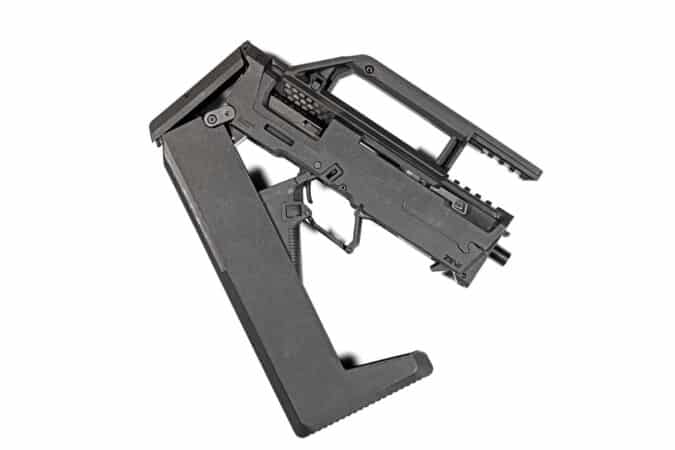

In 2019, ZEV unveiled the OZ9, their modular Glock-ish pistol. It featured a steel receiver running the full length of the pistol, with an integrated locking block, Picatinny light rail, extended frame rails, and housing for the trigger. Grips were interchangeable, and the slide assembly was fully Glock-compatible.
ZEV’s OZ9 steel receiver was the key to this collaboration, representing the foundation for transforming Magpul’s original vision into a production gun. ZEV got to work with Magpul to update their chassis and modify the receiver to nest in it.
First, they trimmed it down and chopped off the dust cover, which wasn’t needed in the folding chassis. Next, since the trigger has to collapse when folded, the usual trigger safety dingus had to be replaced with a manual safety. Finally, the tang was extended to accommodate the latch for the folding grip.
Otherwise, trigger components are unchanged. Parts commonality was important to keep costs from spiraling out of control. Besides the receiver, the differences compared to a standard OZ9 include the folding trigger shoe, manual safety, and ejector housing.
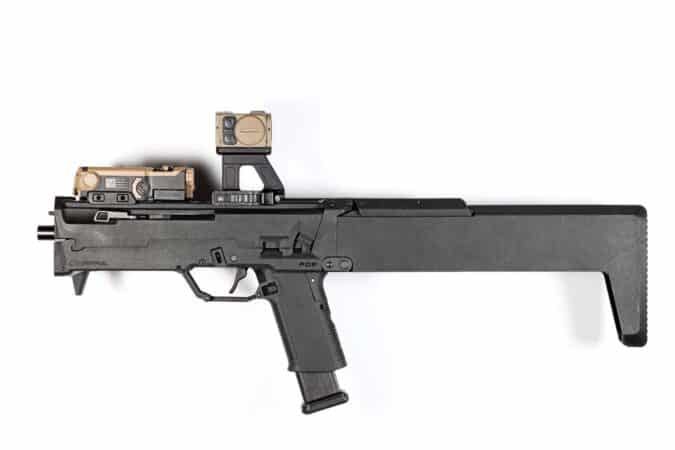
The 17-4 stainless steel slide is slick, lacking sight cuts and serrations, while the 416R stainless steel, 1:10 twist barrel is 7.1 inches long with a slight step down in the profile as it protrudes from the slide — though none of this is visible unless you fieldstrip the gun.
The folding polymer chassis comes in two parts. The top cover incorporates an ambidextrous charging handle that engages the slide beneath it to charge the weapon. It has a large ejection port for cases kicked out when the slide reciprocates. On top is a Picatinny rail, to which a polymer carrying handle with integrated iron sights is attached. The adjustable rear sight is a notch, while the fixed front sight is a blade.
Not only is there some rail space in front of the handle for accessories like a light or laser, there’s a short Pic rail on the underside of the cantilevered handle as well. If you don’t need the carrying handle, you can remove it and attach an optic directly to the top rail, though you’ll need a tall mount because the comb for your cheek is at the same level as the top rail.
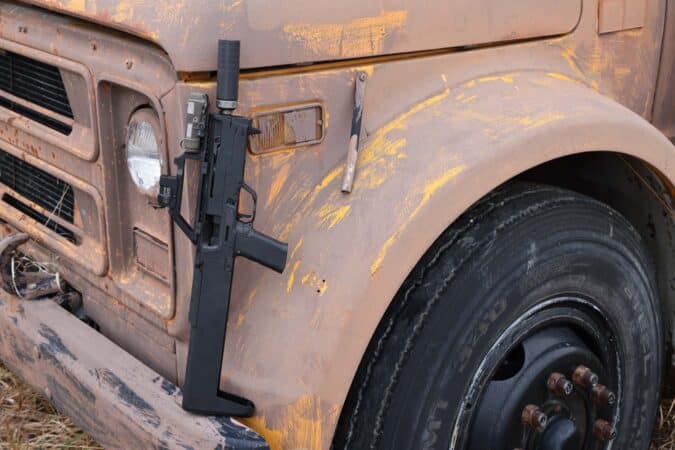
The lower portion of the chassis houses the receiver and Rube Goldberg folding mechanism. Half of it is the folding stock (on the FDC-9), which swings forward to enclose the collapsing grip and trigger guard. The grip, of course, accepts Glock magazines; the ZEV ships the gun with two Magpul PMAG 17 GL9 mags. The FDP-9 pistol version has a sling swivel on the rear and no toe, so it doesn’t function as a stock.
The other half takes the receiver, with the manual safety and slide release on the left side. The grip pivots forward on a pin just above and in front of the trigger shoe, which also folds forward. The two-piece trigger guard collapses as the grip goes forward. Finally, a small grip stop on the bottom near the muzzle also collapses inward as you fold the gun closed.
To fieldstrip the FDC/FDP, first ensure it’s fully deployed and completely unloaded, with no magazine and no round in the chamber. Remove the top cover by drifting a pin at the rear and pulling it upwards. This will expose the innards, where you’ll see the OZ9 within. Safely drop the striker, then retract the slide slightly and pull down on the slide lock/takedown lever, just like a regular Glock. Then, pull the slide assembly out, remove the recoil spring assembly and barrel, and you’re done.
To deploy the weapon, depress the front of the charging handle. This will allow it to open. Two things need to lock into place — the grip and the stock. While you can manually push them into place, it’s much quicker and a lot more fun to let gravity do most of the work. We found it most effective to grab the carrying handle and hold the gun vertically, muzzle up. Press the charging handle and it’ll drop down; add a subtle — not too drastic — flick to hasten it and ensure it locks solidly in place. With practice, we got smoother and more consistent with very quick deployments.
To fold the gun, press the grip latch on the back of the grip to free it. Then, press the latch on the top of the stock to unlock it. Now, you can swing it around on the main hinge to close everything up. This isn’t nearly as quick as deploying the gun, but you’ll get smooth with time. And just as with reholstering a pistol, no need to rush while packing up your FDC-9. Once folded, it’s just 10.8 by 6.4 by 1.5 inches and weighs in at 3.25 pounds.

You can safely fold it up and carry it loaded, for rapid deployment when needed. There’s a pivoting charging handle on both sides; they’re small and a bit stiff, which makes sense since it’s exerting force offset from and at the end of the slide. The manual safety isn’t that ergonomic to operate with your firing thumb due to its position relative to the grip; it’s also inset to avoid snags. We actually found it easier to operate with our support hand. If you have a long thumb, you may have better luck.
We tested preproduction models, in many configurations with a variety of sights, optics, lights, and lasers. Some had slick, prototype aluminum carry handles with integrated ACRO mounts, and some had threaded barrels for more hushed fun.
The slides on some of these preproduction guns were contacting the inside of the chassis, causing occasional malfunctions. ZEV is making adjustments to remedy this for production guns.
With Speer Lawman 147-grain TMJ, we measured muzzle velocities out of the 7-inch barrel at an average of 1,064 fps. As a stocked PDW-style weapon, it was easy to put rounds right on target very quickly, even more so with a red dot. Transitions were quick and recoil impulse very mild. We mowed down plate racks and various courses of fire with aplomb. You feel like you belong in a Robocop movie — the second one to be precise; ask for Hob.
We had magnified optics on some of the guns, and it was no problem to ring steel at 200 yards with them.
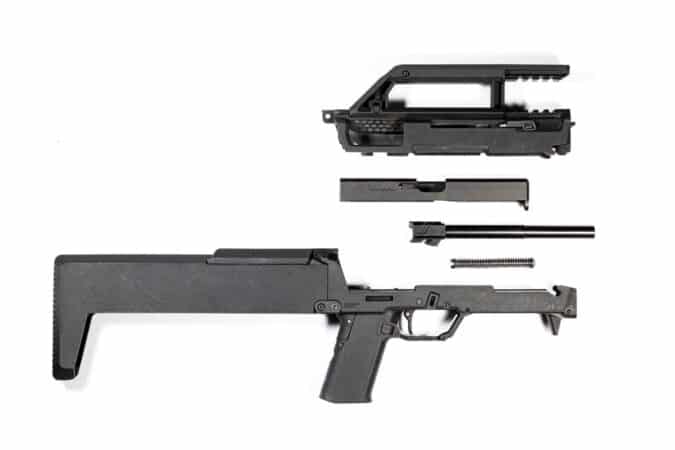
The FDC-9 is a seriously capable gun, as you should expect from essentially a 7-inch Glock with a stock. It’s also incredibly fun and undeniably cool. But how practical is it?
It’s basically a PDW with the twist of folding up into a discreet, non-gun-looking package. Like any pistol-caliber PDW with a stock, you can shoot it faster, with more control, and more accurately than a regular pistol. Plus, you get more velocity for better terminal performance from the longer barrel. It’s not a rifle, shooting rifle-caliber rounds, but those are much larger. If a PDW sounds good to you, the FDC/FDP certainly delivers.
On top of that, it folds up into a little rectangular box. While it slows down your time to first shot, it provides a really discreet, compact, low-vis package — not just in plain view but, importantly, in profile, such as in a bag or stowed somewhere. In contrast, other PDWs are generally larger and clearly look like and are shaped like guns. This could be important for those in non-permissive environments and with deep concealment needs.
Note that attaching optics and accessories start to break the illusion if they’re visible; however, stashed in a bag it still retains a decidedly non-gun outline.
Additionally, there’s absolutely nothing wrong with wanting a gun simply because it’s badass.
The ZEV X Magpul FDC/FDP-9 isn’t a mass market gun, nor does it have a price tag that would support that. But it does have a particular set of skills. And if that particular set of skills appeals to you, you’ll love it.
Read the full article here

